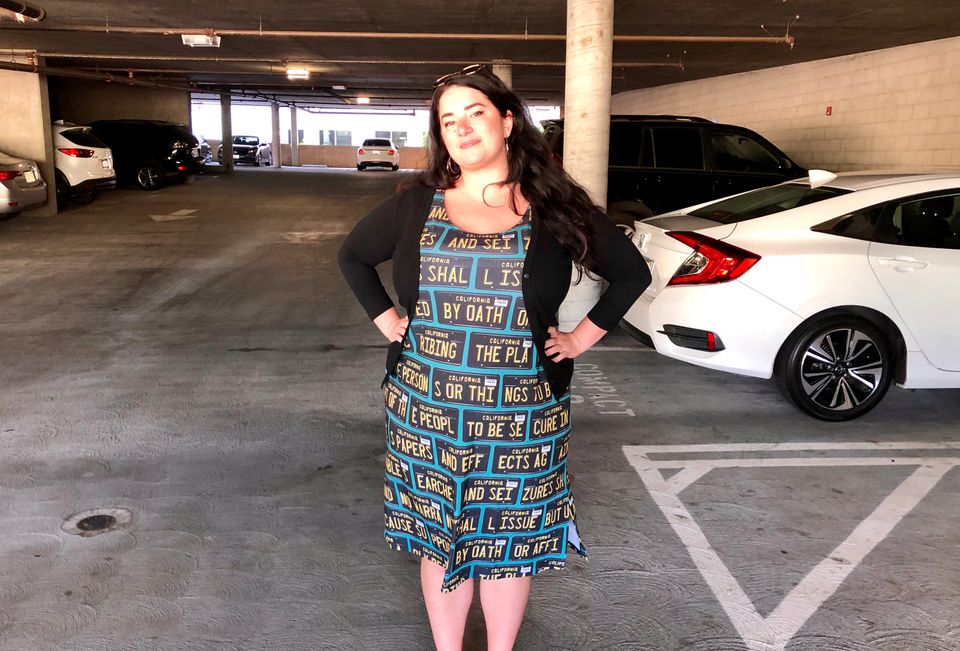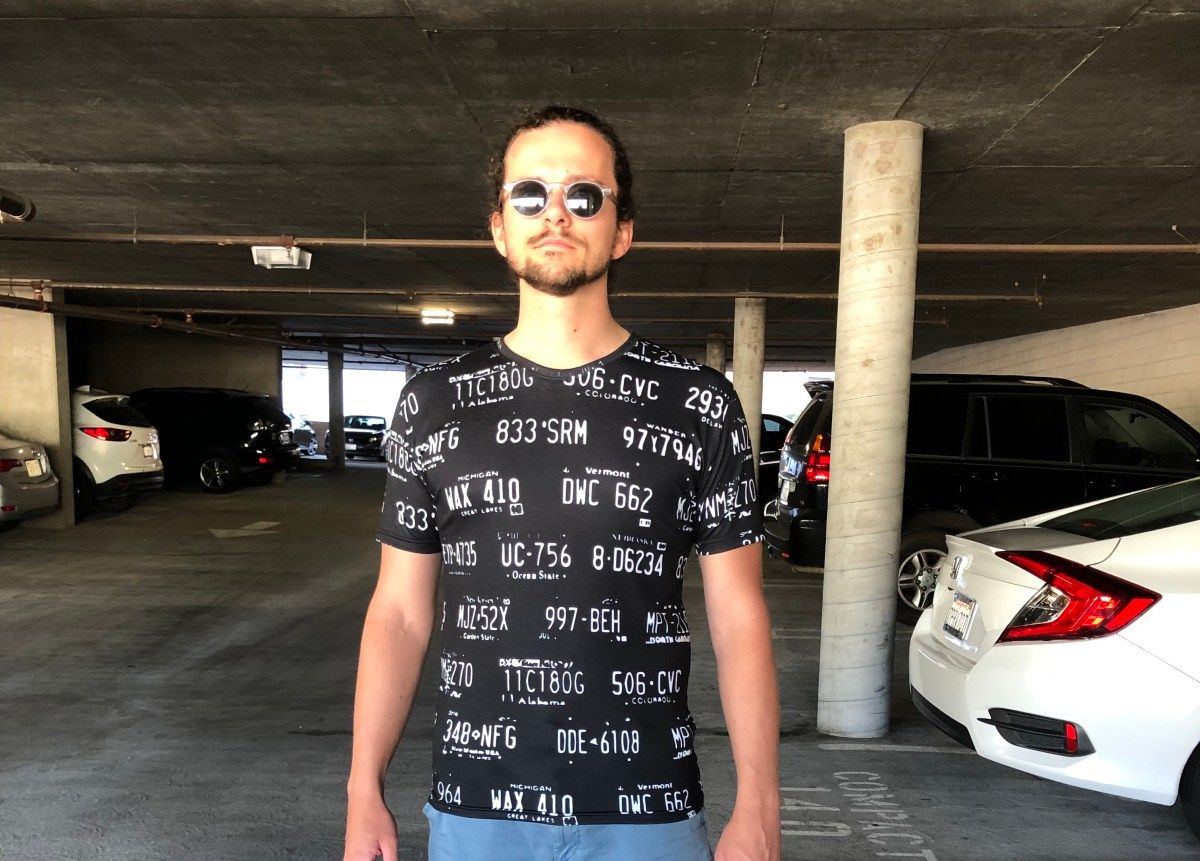A hacker’s fall fashion line features faux license plates. Here’s why

LAS VEGAS—Are you too sexy for your license plate? Hacker and fashion designer Kate Rose thinks not.
Until now, most antisurveillance fashion has surrounded ostentatious pairs of glasses or face jewels meant to fool (or at least bring attention to the potential privacy ramifications of) facial-recognition technologies. For the fall season, Rose decided to target car-tracking technologies.
At the hacker conference DefCon here Saturday, Rose is debuting T-shirts, pencil skirts, and crop tops containing neither fancy LEDs to blind sensors nor clever wiring to conceal one’s identity. Instead, her Adversarial Fashion line is made of “high-quality cotton” printed with edgy patterns of numbers and letters resembling framed license plates.
Law enforcement agencies use automatic license plate readers, or ALPRs, to collect license plate numbers at specific times and locations. An ALPR can collect thousands of plate numbers per minute.
READ MORE ON SURVEILLANCE
Looking beyond the surveillance state
Jennifer Granick on spying: ‘The more we collect, the less we know’ (Q&A)
Garry Kasparov takes on the Russian surveillance state (Q&A)
‘State of Control’ explores harrowing consequences of surveillance
How to strike a balance between security and privacy (Q&A)
New research explores how the Great Firewall of China works
While the plate reader databases don’t contain names of car owners or drivers, the digital-rights group Electronic Frontier Foundation says law enforcement agencies can access other government databases with that information. By combining and comparing data across databases, it says police can track vehicle locations throughout the day.
Reported law enforcement abuses of license plate reader databases include police pulling over at gunpoint a pregnant African-American woman in San Francisco; blackmailing people suspected of patronizing a gay bar in Washington, D.C.; and targeting a Muslim community in Birmingham, Ala.
Rose says she owes the inspiration for her license plate fabric designs to Dave Maass, a senior investigative researcher at the EFF, whose work contesting law enforcement use of ALPRs has led the organization to sue the Los Angeles Police Department and the LA County Sheriff’s Department, as well as file legal briefs in a Virginia case.
“In California, you can’t interfere with a license plate reader by law, except to cover your license plate when you cover your entire car to protect it from the elements,” Maass says. “We’ve been trying to figure out how to deal with license plate readers for some time. How do you write a law restricting license plate readers without banning people from taking photos in public? It’s a really hard First Amendment issue.”
During the winter of 2015-2016, Maass says, he realized that “if you put up enough of your license plates around a city like Oakland, it would render [ALPRs] ineffective. Police would have to assume that the data was all garbage—they couldn’t tell what was a real hit.”
Like most contemporary fashion designers, Rose wants her fabric to be seen. In this case, however, she’s taking a page from Maass’ discovery: She wants it specifically to encounter as many automatic license plate readers as possible, from the densely populated streets of New York to the urban sprawl of LA.

Rose tested her license plate designs with commercially available apps and APIs such as OpenALPR and EasyALPR until they triggered accurate scans. When an ALPR sees the fabric, she says, it’ll add its fake license plate numbers (and letters) to its databases, thus adding clutter to the data. Adding a significant amount of noise to a license plate database, she says, might make it harder for a law enforcement agency or a private data broker to accurately and inexpensively track people’s locations. For now, though, the point is to call attention to the tracking in the first place.
“We’ve had known data breaches by [government] contractors at the border. Is wearing a T-shirt going to change that? No. But how can I make that data less useful?” Rose said in a phone interview before DefCon. “The more garbage they are forced to collect, the more it costs them to collect it, to store it, to analyze it. Making it expensive, difficult, being noncompliant in any way you can—it’s all about changing that culture of data collection.”
She says she designed the fabric to use plate numbers already available online in public data sets, such as those used in illustrations and decorations, to avoid linking her designs to real people as much as possible. Rose also has made the resources she used in making the fabric available for free to other designers.
Rose’s license plate patterns, while niche, point toward a more comprehensive form of anti-surveillance fashion, says hacktivist Elle Armageddon.
“It seems like a lot of the aesthetic choices people make around circumventing surveillance are focused on the concept of ‘no face, no case,’” she said in a text message, “which fails to take into account things like body type, gait analysis, even tattoos and other distinguishing features.”
Fooling computer vision algorithms is not straightforward. A difference of three pixels could make an image recognition program identify a turtle as a gun. A poorly trained machine-learning algorithm might also get a woman falsely charged with jaywalking.
Rose had to make sure that what was recognized as a license plate when printed on test paper would do the same when printed on lower-resolution fabric. After multiple tests, she finally found success in creating a fabric-printed font that license plate readers would recognize; they had ignored the commercial license plate fonts.
Rose says infusing fashion with hacker values and aesthetics makes those values more accessible to people who might not consider them otherwise.
“DefCon is going through a wonderful phase right now, where it’s like a hacker craft fair,” she says.
